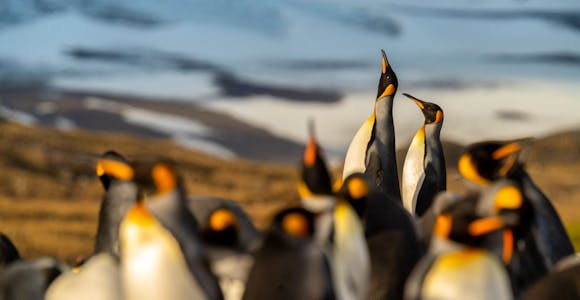
Penguins of South Georgia
From the epic king penguins colonies to the island's macaronis, gentoos and chinstraps, penguin are the reason so many people want to visit South Georgia.
Discover MoreSpecial Offers Available: Swoop has access to the widest range of offers and can help you find the right trip, cabin, & price.
Expert impartial advice at no extra cost: no-nonsense advice on 1500 voyages across 30 ships
The Antarctic Experts. No Compromises: there’s no question we can’t answer
The only B Corp certified Antarctic specialist: so your adventures can be a force for good
A full concierge service, unlike booking direct: we leave nothing to chance in delivering your perfect trip
Special Offers Available: Swoop has access to the widest range of offers and can help you find the right trip, cabin, & price.
Expert impartial advice at no extra cost: no-nonsense advice on 1500 voyages across 30 ships
The Antarctic Experts. No Compromises: there’s no question we can’t answer
The only B Corp certified Antarctic specialist: so your adventures can be a force for good
A full concierge service, unlike booking direct: we leave nothing to chance in delivering your perfect trip

Numbers alone simply can’t do justice to how extraordinary the wildlife of South Georgia is. This is the Serengeti of the South, where penguins and seals are counted in the millions. At the height of the breeding season, there is said to be more wildlife per square metre here than any other place on the planet – something that truly has to be seen to be believed.

King penguins at Fortuna Bay
If there's one reason that wildlife lovers put South Georgia so high on their wish list, it's the penguins. We don't blame them. Four species of penguins breed on South Georgia: kings, macaronis, gentoos and chinstraps. Of these, the most numerous are the macaroni penguins, with their exuberant yellow eyebrow feathers, but it's king penguins that are the real showstoppers.
The king penguin colonies at St Andrews Bay, Salisbury Plain and Gold Harbour quite simply offer some of the most incredible birdwatching on the planet. Penguins accompany you from the moment you land on the beach all the way to the colonies where the birds are numbered in the hundreds of thousands. The noise is deafening, both from the trumpeting of the adults to the whistles of the chicks, who are present year-round.
Most visitors are lucky enough to spot all four penguin species on their trip to South Georgia, but it you want to tick them off in one go, cross your fingers for a landing at Cooper Bay, the only place on the island where all four species breed.

Fur seal pup on Prion Island
In terms of sheer biomass, the Antarctic fur seal is South Georgia's dominant species. They were hunted almost to extinction for their pelts in the early 19th century, but modern surveys have had trouble keeping track of their every growing numbers. New research published in 2023 suggests that the island is home to around 3.5 million fur seals, representing over 95% of the world's population.
It's a number that's easy to believe when you visit. In November and December the beaches are packed with males claiming their breeding territories, and their aggressive demeanour can sometimes make going ashore a real challenge. After this the shores froth with huge numbers of fur seal pups cute enough to launch a thousand internet memes – guides often refer to the seas here as being 'fur seal soup' there are so many of them.

A male elephant seal about to begin his summer moult
Half of all the world's southern elephant seals make their home around South Georgia, numbering perhaps 400,000 individuals. They spent most of their lives at sea, but in October the males come ashore to fight over great harems of females. The largest males are known as beachmasters, over 5m long and four tonnes in weight: often three times the size of the females. Jousts between competing males make a formidable sight.
Pups are born from November and grow fat until they are known as weaners. Adults return to shore after January for their annual moult, when they shed old skin in muddy wallows. During this time, few animals can match them for their moth-eaten appearance during this time – or their constant chorus of belches and farts.
A small number of Weddell seals breed at the very southern tip of South Georgia around Drygalski Fjord. Leopard seals are also sometimes seen on beaches, but they are summer visitors only and do not breed here.
Seeing all of the wildlife was absolutely fantastic. The level of expertise of the staff on board and the quality of the excursions was one of a kind! Read the full review
Travelled: February 2025
Sadie Neve - UK
St. Andrew’s Bay South Georgia probably stands out as the most memorable. To be able to walk among the hundreds of thousands of king penguins, elephant seals, fur seals, albatross and other sea birds with a backdrop of glaciers and mountains ending at the sea was beyond imagination. Read the full review
Travelled: February 2025
Michele Krantz - USA
10/10 - The entire trip was excellently conducted and managed with many zodiac cruises and landings. The wildlife viewing was outstanding including: penguins, seals, birds, and whales. Read the full review
Travelled: February 2025
William Atkins - USA
Most memorable moment? Immersing myself in the huge king penguin colony on South Georgia Island. Read the full review
Travelled: February 2025
William Atkins - USA
Most memorable moment? The thrilling view of the expansive collection of king penguins on South Georgia Island - St. Andrew's Bay and Gold Harbor. Read the full review
Travelled: January 2025
Alisa Schreier - USA
Most memorable moment? Seeing the thousands and thousands of penguins at Salisbury Plain, South Georgia.
Travelled: January 2025
Andrew Mail - Canada
Most memorable moment? Seeing the most beautiful ice and 7 types of penguins. Read the full review
Travelled: January 2025
Amy M Mundt - USA
10/10 - Everything was perfect - the excursions, the guides, the ship - each place was different and we saw every animal on our checklist. Read the full review
Travelled: January 2025
Robin Schelstraete - USA
Most memorable moment? Seeing the breathtaking volume of penguins in South Georgia and the thrill of paddling on the water and seeing seals on an ice sheet at eye level! Read the full review
Travelled: January 2025
Ibby Carothers - USA
Bottom line, I'd go back to South Georgia as a destination in and of itself - we both thought it surpassed Antarctica on a number of levels (scenery, wildlife density, historical, etc).
Travelled: January 2025
John Wilke - New Zealand
10/10 - Every day just got better till our last, which was a bit snowed out and windy at the end. Most memorable moment? All the abundant wildlife, including whales and penguin colonies. Read the full review
Travelled: December 2024
Paul Kortopates - USA
Most memorable moment? The immense penguin colony(s) in St. Andrews Bay on South Georgia. Read the full review
Travelled: December 2024
Walter Blom - Netherlands
10/10 - I would do it all over again. Most memorable moment? Seeing the masses of frolicking penguins and seal pups in South Georgia.
Travelled: December 2024
Colin Isenman - UK
Most memorable moment? Watching thousands of moulting king penguins lining the meltwater streams from Nordenschild Glacier at St Andrews Bay, South Georgia. Wow! Read the full review
Travelled: December 2024
Drew Wilson - USA
The splendour of the scenery in Antarctica and the enormous amount of wildlife on South Georgia was still breathtaking and even more impressive than any photo could ever convey. I left Antarctica, especially, disappointed in the quality of my photos - they completely fail to convey the scale and grandeur of the place and I'm pretty sure that's not just a reflection of my photography skills. Read the full review
Travelled: December 2024
Drew Wilson - USA
Most memorable moment? The wildlife and landscape of South Georgia Island. Read the full review
Travelled: December 2024
David Slater - Australia
Most memorable moment? Standing above a colony of over 300,000 king penguins at Saint Andrews Bay, South Georgia. Read the full review
Travelled: December 2024
Karen Downing - United States Minor Outlying Islands
Most memorable moment? The penguins of South Georgia. Read the full review
Travelled: December 2024
Dan Salter - UK
Most memorable moment? On shore with the wildlife in South Georgia. Read the full review
Travelled: December 2024
Malcolm Pryor - UK
Most memorable moment? The hundreds of thousands of king penguins, plus elephant seals and fur seals at South Georgia Island and then the majesty of the icebergs, ocean, mountains, and glaciers at the Antarctic Peninsula. Read the full review
Travelled: November 2024
Rebecca Melonakos - USA
Most memorable moments? Standing on South George island among a million king penguins and seals and kayaking among beautiful iceberg forms. Read the full review
Travelled: November 2024
Stephen Sharp - USA
My advice? Don't miss South Georgia. My most memorable moment was being with tens of thousands of king penguins on South Georgia. Read the full review
Travelled: November 2024
Silvia Schriever - Canada
10/10 - It was an amazing lifetime experience. Most memorable moment? Being present with the abundance of penguins, elephants, seals and albatross birds, to be part of their lives and be able to appreciate how they live and survive. Read the full review
Travelled: October 2024
Cheong Kin Seng - Malaysia
10/10 - The trip is not complete without visiting South Georgia Island and wildlife on the island. Our most memorable moments were the pristine landscape of the continent and wildlife on South Georgia Island in their natural habitat. Read the full review
Travelled: March 2024
Brad Amaraneni - UK
Most memorable moment? When we landed on Fortuna Bay in South Georgia surrounded by king penguins and seal pups. Read the full review
Travelled: March 2024
Padmaja Sakhamuri - UK
10/10 - Outstanding adventure, Antarctica is so wonderful and South Georgia was something else. We saw a lot of it in documentaries, but seeing it in real life was like standing amidst a National Geographic documentary. Read the full review
Travelled: March 2024
Prasanth Sakhamuri - UK
I find it impossible to choose one memorable moment. All of the wildlife on South Georgia, albatross fledglings testing out their wings on West Falklands, landing at Wild Point on Elephant Island...I could go on and on and on. Read the full review
Travelled: March 2024
Linda Smith - UK
Most memorable moment? Seeing thousands and thousands of penguins in South Georgia. Read the full review
Travelled: February 2024
Farhad Vatcha - USA
Most memorable moment? The king penguin colony on South Georgia Island and the albatross and rockhopper penguins on one of the Falklands Islands. The naturalists’ enthusiasm, knowledge and willingness to share their knowledge exceeded expectations. Read the full review
Travelled: February 2024
Patricia Coughlan - USA
There are so many memorable moments!! Fortuna Bay surrounded by thousands of king penguins and hundreds of juvenile fur seals. The history at Grytviken, with the story of Shackleton. Read the full review
Travelled: February 2024
Doug Pemberton - Canada
Most memorable moment? King penguin colony with fur seal pups playing in the surf. Read the full review
Travelled: February 2024
Franz Scherubl - Canada
Most memorable moment? The numerous wildlife encounters. Really enjoyed seeing all the different species of seals and penguins in their natural habitat. Read the full review
Travelled: January 2024
David Flack - Japan
10/10 - Being in Antarctica was an amazing experience - but South Georgia and the Falklands added another level to the trip, especially for wildlife. Read the full review
Travelled: December 2023
Lesley Croskery - South Africa
Most memorable moment? St. Andrews Bay and seeing the entire beach covered in king penguins and their babies. Also cruising through icebergs and seeing the calm/still sea in Antarctica. Read the full review
Travelled: December 2023
Mary Abraham - USA
My love and respect for the animals has increased, and I am so glad I was able to learn more about them and all of the places that we visited. Read the full review
Travelled: December 2023
Deb Smith - USA
There were so many memorable moments. Seeing a pod of Killer Whales, setting foot on the 7th continent, the elephant seal pups looking up with those adorable eyes, the king penguin chicks running and flapping around trying to shake off their down coats. What a trip! Read the full review
Travelled: November 2023
Neil Gibson - Australia
So much wildlife - penguins, sea birds, whales, dolphins - and beautiful icebergs that were all different. Nature is so beautiful & a brilliant artist. Add to that the wonderful scenery & you are in heaven. Loved it. Read the full review
Travelled: March 2023
Cecilia Griffin - UK
Penguins on South Georgia were amazing, as were the seals. Read the full review
Travelled: March 2023
David Feldshon - USA
Even though traveling to South Georgia and the Falkland Islands added to the length and expense of the trip, it was well worth it. You will not see wildlife and scenery like that found on these islands anywhere else in the world. Read the full review
Travelled: February 2023
Donna Potaczek - USA
The opportunities to see, hear, and move among the penguins, sea birds, seals, and whales was truly special. We learned so much, experienced so much it is hard to pick a favorite moment. Many truly 'close encounters.' Read the full review
Travelled: December 2022
Michael Cox - USA
Review:

A northern giant petrel takes to the sky
If you want proof of South Georgia's importance as a wildlife haven, look no further than the numbers of seabirds nesting here: a million pairs of white-chinned petrels, 6 million pairs of diving petrels and an almost unimaginable 25 million pairs of Antarctic prions. Sometimes you just won't know where to point your binoculars.
Although smaller in numbers, albatrosses are the charismatic seabirds that most visitors are keenest to see. Wandering albatrosses, the world's largest seabird, nest in several locations on the north of the island, and at certain time of the year can be seen on their nests at Prion Island. While on zodiac cruises elsewhere, lookout for the cliffside nests among the tussock of the grey-headed albatross, black-browed albatross and light-mantled albatross. Elsehul is one of the best locations for spotting albatross on the wing. The cliffs are also where you'll spot the nests of blue-eyed shags (imperial cormorants) and kelp gulls.
Other seabird species are more closely associated with the beaches. Where there are penguin colonies you'll find predatory brown skuas nesting nearby. Antarctic terns also favour the glacial outwash plains popular with king and gentoo penguins. Giant petrels (both the northern and southern variants) invariably scavenge around the beaches looking for carrion: a flock can reduce an elephant seal carcass to skin in just a few hours. Expect to see snowy sheathbills also pecking around; they're very curious and will investigate anything you've put on the ground.

Humpback whale comes up for air
South Georgia was where the Antarctic whaling industry was born in the early years of the 20th century and its seas were the first to be plundered of whales. In the last 50 years, numbers are slowly starting to recover.
Most astonishing of all are the humpback whales, whose numbers are now regarded as having almost completely returned to pre-whaling levels. They start to arrive from their tropical breeding grounds in November and are frequently sighted between South Georgia and Antarctica. Humpbacks are easily identified by their long white pectoral fins.
Fin whales – the second largest of the great whales – are also in residence at this time, particularly off the island’s southern coast, and their numbers are also believed to be on the rise. Look for the distinctive curved dorsal fin, and their asymmetric jaws (one is pale, the other dark).
Blue whales have been much slower to show signs of recovery and sightings remain rare. Their sheer bulk and small dorsal fin located well back on the body make them very distinctive.
The Southern Right Whale, the first whale to be driven almost to extinction, is making the slowest progress towards population recovery. Right whales are rarely seen, but if spotted are likely to be close to shore.
South Georgia can almost a bit overwhelming because you don’t know where to look – there’s so much wildlife and there’s so much going on at the same time! You need to just stand still for a long time and take it all in step by step.
Matias Polar wildlife guide

South Georgia pipit (Image: South Georgia Heritage Trust/Oli Prince)
Don't be surprised if you hear your guide getting excited about hearing the trill of bird song on a landing: they'll have just heard the call of the endemic South Georgia pipit, the world's most southerly songbird. It's something to celebrate as a few years ago they were reduced to just a few outlying islands due to predation of their nests by rats introduced during the whaling period. A five year, multi-million dollar habitat restoration programme led by the South Georgia Heritage Trust finally saw the island declared rat free in 2018. The pipit has been quick to recolonise the mainland, along with the lovely South Georgia pintail duck, another endemic. You might come here for the penguins, but spotting a train of ducklings following their mother is one of the most optimistic sights you can find on the whole island.
Many invasive plant species were also introduced accidentally by whalers, and efforts are ongoing to control and eradicate non-native species. The risk of accidentally transferring seeds from one location to another on the island is a key reason why biosecurity procedures must be strictly followed throughout the entirety of a visit.

South Georgia pintails (Image: South Georgia Heritage Trust/Oli Prince)
As a result of careful management overseen by the Government of South Georgia & the South Sandwich Islands, South Georgia is now regarded as that rarest of things: an ecosystem in recovery. The island's maritime protection zone extends 200 nautical miles, covers nearly one million square kilometres and is one of the most strictly monitored in the world. As a result, albatross mortality in these waters because of long-line fishing has been virtually eliminated, while quotas for krill fishing are set deliberately low for the protection of the species that depend on it.
Visitors may see the government's bright red ship Pharos that monitors fishing in its waters, as well as sometimes carrying out impromptu inspections of expedition cruise ships to ensure they are adhering to strict biosecurity protocols.
Special Offers:Swoop has access to the widest range of offers and can help you find the right trip, cabin, & price.
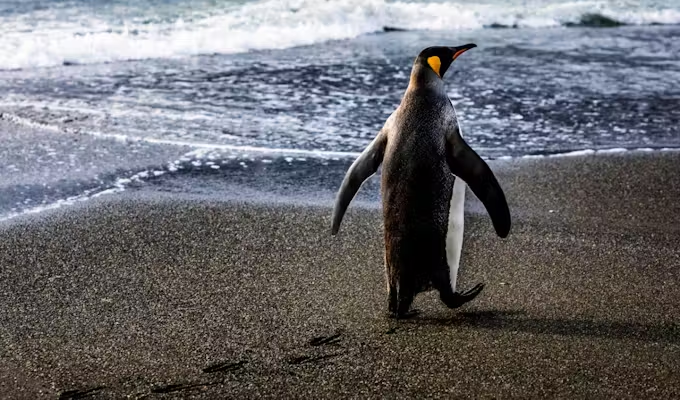
4.6 out of 5
This voyage takes in the wildlife-rich wonders of South Georgia and the Falklands, as well as the dramatic landscapes of the Antarctic Peninsula. You’ll travel on board one of the most exciting new polar ships with spacious cabins, state-of-the-art technology…
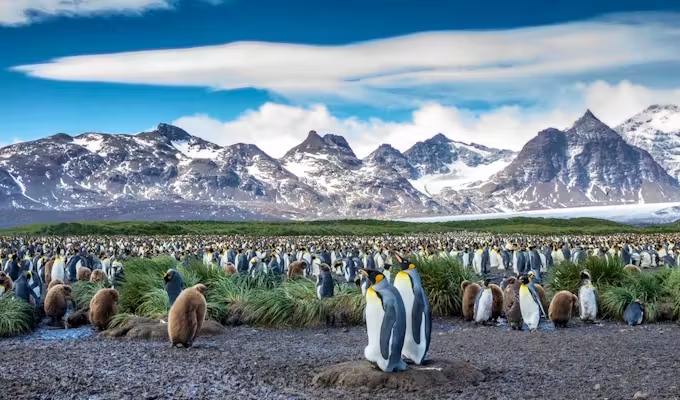
4.9 out of 5
Voyage south in Shackleton’s footsteps, exploring the Southern Ocean's highlights as part of this expansive 20-day adventure. A well-balanced itinerary gives plenty of time in each jaw-dropping location. Explore from the comfort of your sleek purpose-built expedition ship, accompanied by…
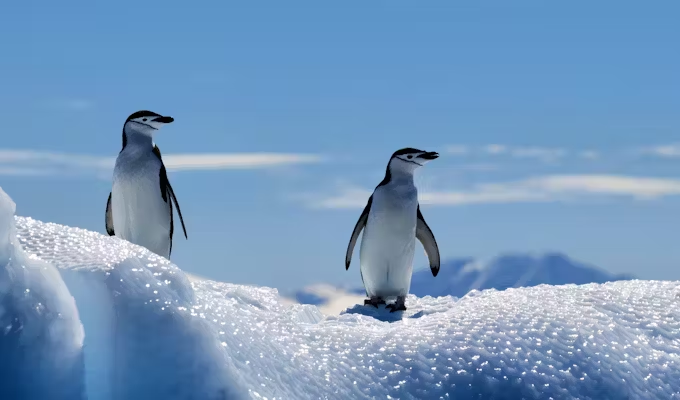
4.6 out of 5
With a good choice of departure dates through the season across three medium-sized ships, this 19-22 day trip stands out for its value for money and the broad range of cabin categories available, including Quads, which are…
There is no best time to visit South Georgia as you are guaranteed animals in vast numbers at any time. The king penguin's unusual breeding cycle means that chicks are present throughout the year. From January, the island abounds in fur seal pups.
For a month-by-month guide to what the wildlife will be doing during your visit, see our page When to visit South Georgia.
Keen birders should check that their visit coincides with when Prion Island is accessible.
Prion Island is renowned for its nesting wandering albatross. Access to the island is strictly controlled; it's closed to all visitors between 20th November - 7th January inclusive to match the fur seal breeding season, so time your visit outside these dates if these beautiful birds are high on your wish list. Access is controlled by permit and not all expedition itineraries visit Prion Island, so if this is a top priority for your visit please let our specialists know so they can recommend the best suited trip for you.
Very close is the short answer! The sheer density of South Georgia’s wildlife and their lack of fear of man means that challenge isn't getting close to wildlife, it's giving them enough space. It's not uncommon to find yourself being approached by a curious penguin or a fur seal pup full of false bravado.
Maintain a distance of 5m from wildlife at all times, and 10m from the edge of penguin colonies. If an animal approaches you, slowly move away. Remember that wildlife on South Georgia always has the right of way and if anything you do causes an animal to change their behaviour, you're too close and should quietly move away.
Absolutely. On board you'll find a variety of guides with a wealth of wildlife experience to tell you more about the animals you're seeing – both while you're on shore and during dedicated talks on the ship. Expert guides are an integral part of the expedition cruise experience, so don't be surprised if your guides have a background in scientific research in the region as well as working with tourists.
Yes. South Georgia is a wildlife photographer's paradise so it attracts a higher than usual proportion of travellers who are seriously dedicated to their cameras. Landings are always planned to maximise your time on shore. Many ships will also have their own photography guide on board.
Such is the density of wildlife here however, the problem is not finding a subject to photograph, it's being overwhelmed with so many places to point your camera at!

From the epic king penguins colonies to the island's macaronis, gentoos and chinstraps, penguin are the reason so many people want to visit South Georgia.
Discover More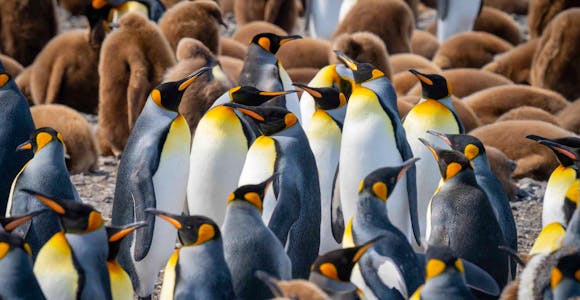
Even on an island that abounds with incredible wildlife encounters, the vast king penguin colony of St Andrews Bay is truly something special.
Discover More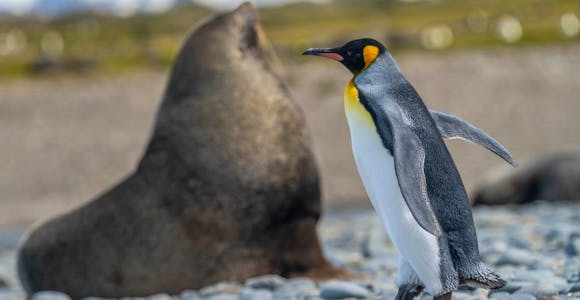
With its amphitheatre-like mountains and large numbers of king penguins and elephant and fur seals, Salisbury Plain is as truly jaw-dropping as South Georgia gets.
Discover More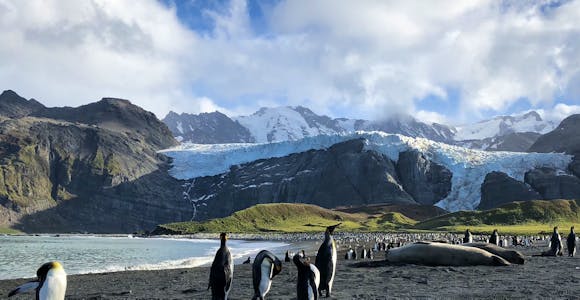
With its hanging glaciers towering over a beach dense with penguins and seals, few locations in South Georgia are as dramatic as Gold Harbour.
Discover MoreWe'll spend some time listening to your aspirations, then discuss the kind of experience that might suit you.
Next we'll discuss the options, shortlist the best trips for you and present you our impartial recommendations.
We'll place a 24 hour hold on your preferred option - without obligation - whilst we talk through the details.
With over 100 years of South Georgia experience between us, we can help you to exactly the right trip for you.
1-888-970-4570This website uses cookies to ensure you get the best experience on our website. Privacy policy